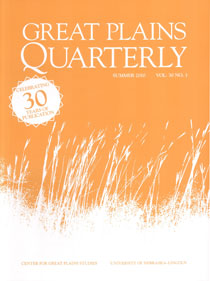
The fall issue of Great Plains Quarterly, an academic journal published by the Center for Great Plains Studies at UNL, features articles about displaced communities due to flood control in Kansas in the early 20th century, Americans traveling across the plains in search of tuberculosis cures, and the 1979 designation of "Wilderness" in the Black Hills.
In "'If the Lord's Willing and the Creek Don't Rise': Flood Control and the Displaced Rural Communities of Irving and Broughton, Kansas," Robin A. Hanson writes about how the residents and their descendants of two displaced rural Kansas towns have maintained ties to their small farming communities even after the physical reminder of those towns no longer exists. The Flood Control Act passed by Congress in 1936 authorized the construction of several reservoirs in the Missouri River basin including the Tuttle Creek Dam and the Milford Dam. "The dams may have brought prosperity to larger cities farther down the river, but they destroyed the economy, the homes, and the sense of belonging for those living in the Big Blue River Valley and along the lower Republican River," wrote Hanson, who teaches history and anthropology at Jefferson College and Saint Louis Community College.
Jeanne Abrams tracked people with tuberculosis from the mid-19th century through the first decades of the 20th century for her article, "On the Road Again: Consumptives Traveling for Health in the American West, 1840-1925." Abrams wrote, "Hundreds of health seekers, on the advice of their physicians, family members, or popular advertisements, took to the road to 'chase the cure' for tuberculosis, the most dreaded disease of the era. Indeed, tuberculosis, also commonly known as consumption or 'the White Plague,' held the dubious distinction of being the leading cause of death in 19th century America." Abrams is a professor at Penrose Library and the Center for Judaic Studies at the University of Denver.
In "Wishlist: Wilderness Endgame in the Black Hills National Forest," Robert Wellman Campbell, assistant professor of history and geography at Black Hills State University, describes the U.S. Forest Service's 1979 Roadless Area Review and Evaluation (RARE II) on designating undeveloped land as "Wilderness" and its impact on the Black Hills. Campbell wrote, "RARE II was meant to settle the political contest that had been fought over wilderness since 1964, as the endgame to decide once and for all the winners and losers among federal lands. RARE II was a modified version of the process dictated by the National Environmental Policy Act of 1970, which by the time of RARE II was already a well-practiced set piece within the broader politics of environmentalism."
Current issues of the journal may be purchased in the Great Plains Art Museum gift shop, 1155 Q St., or by calling (402) 472-3082. Order forms are available online at http://www.unl.edu/plains.
- Linda Ratcliffe, Great Plains Studies
More details at: http://go.unl.edu/4tr